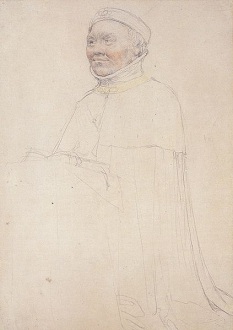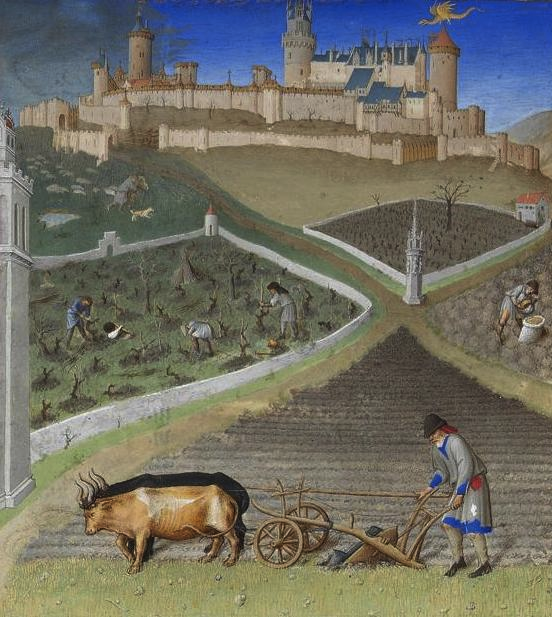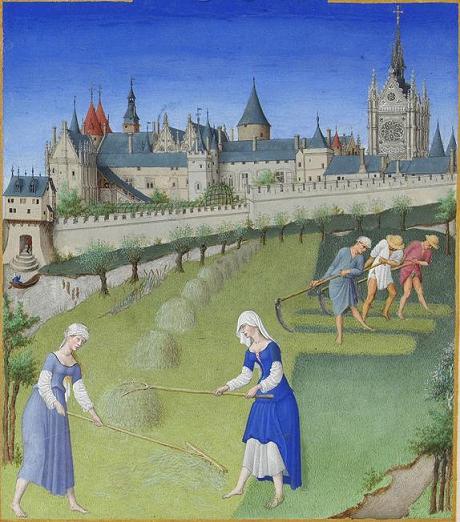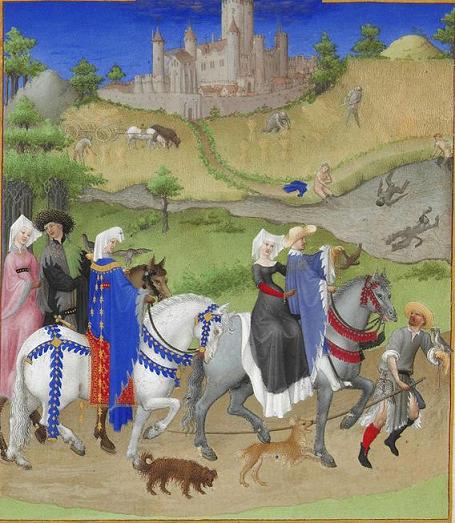
LIFE AS MYTH
![]()
JOURNAL
![]()
JOURNAL 2015
1001 stories
The gift of self
![]()
SPRING 2015
Gathering golden threads
The golden age of illumination
![]()
LIFEWORKS
![]()
ATLAS
![]()

SPRING 2015
THE GOLDEN AGE OF ILLUMINATION
March, Les Très Riches Heures du duc de Berry, 1410. The Musée Condé, Chantilly. This is one of twelve calendar images from Les Très Riches Heures du duc de Berry, a fifteenth century book of hours. Representing the month of March, a farmer works a field with a plow pulled by two oxen. He is directing their course with a long pole. Winemakers prune the vine (left) and aerate the soil with a hoe. On the right, a man is sowing seeds. In the background, a shepherd works with the dog guarding his flock. The castle of Lusignan (Poitou), part of the Duke of Berry's property, appears at the horizon line. Above the castle turn, a winged dragon hovers, representing the fairy Melusine. (below) Hans Holbein the Younger. 1523/24. Kunstmuseum Basel.
Jean, Duc de Berry [1340-1416], was the third of four sons born to King John II of France. He was heavily involved in the court intrigue that surrounded the reign of Charles VI, his nephew who had a mental illness. From 1382-88, he served as Regent along with Charles' maternal uncle, the Duke of Bourbon. When his only surviving brother, Philip the Bold, died in 1404, Jean assumed the role of peacemaker between his warring nephews.
He was married twice. With his first wife, Joanna of Armagnac [1346-1387], he had five children. The year following Joanna's death, he married his second wife, Joan II, Countess of Auvergne and Boulogne [1378-1434].
Jean is perhaps remembered most for his extensive patronage of the arts. His commissions include many illuminated manuscripts as well as the Holy Thorn Reliquary and the Royal Gold Cup, also known as the Saint Agnes Cup. His cultivation of art and artists severely impacted his wealth and whenhe died in the plague of 1416, he was heavily in debt.
Les Petite Heures (The little hours) was commissioned by the duke in 1373. Originally, five illuminators worked on the illustrations, among them Jean Le Noir, the era's leading artist in French book illustration. Art historians credit him with the Passion of Christ, the office of John the Baptist, and an illumination for the penitential psalms. When Le Noir died in 1375, production of the book halted for almost a decade. In 1385 other artists were brought into the project [Jacquemart, Master of the Trinity, and the Pseudo-Jacquemart], completing it by 1390. In 1400, the duke commissioned the Limbourg brothers to add a final miniature. Presently, this book is is part of the special collections of the Bibliothèque nationale in Paris.

The Turin-Milan Hours was commissioned at some point during the decade of 1380-90. It is believed that Jean de Berry is responsible for this commission. The project was an unusual one as it was not intended to be a standard book of hours but rather an extravagantly illuminated manuscript which contained not only the book of hours but a prayer-book and missal as well. In 1413 the Duke gave the book to his treasurer Robert D'estampes who divided the still incomplete manuscript, selling the missal and prayer book and retaining the book of hours.
Très Belles Heures de Notre-Dame de Duc Jean de Berry is the book of hours portion of The Turin-Milan Hours. Robert D'Estampes, treasurer to Jean de Berry, retained this portion of the larger manuscript in his personal effects and it remained in his family until the 1700's. It is now in the Bibliothèque nationale de France, a bequest from the Rothschild family in the 1950's.

(clockwise) June, July, August, September, Les Très Riches Heures du duc de Berry, 1410. The Musée Condé, Chantilly; Jean de France, Duke of Berry, study of a sculpture by Jean de Cambrai. July, Les Très Riches Heures du duc de Berry, 1410. The Musée Condé, Chantilly; October.
The Turin-Milan Hours was commissioned at some point during the decade of 1380-90. It is believed that Jean de Berry is responsible for this commission. The project was an unusual one as it was not intended to be a standard book of hours but rather an extravagantly illuminated manuscript which contained not only the book of hours but a prayer-book and missal as well. In 1413 the Duke gave the book to his treasurer Robert D'estampes who divided the still incomplete manuscript, selling the missal and prayer book and retaining the book of hours.
Très Belles Heures de Notre-Dame de Duc Jean de Berry is the book of hours portion of The Turin-Milan Hours. Robert D'Estampes, treasurer to Jean de Berry, retained this portion of the larger manuscript in his personal effects and it remained in his family until the 1700's. It is now in the Bibliothèque nationale de France, a bequest from the Rothschild family in the 1950's.
Les Belles Heures (Item, une belles Heures, tres bien et richement historiees [Item, a beautiful hours, very well and richly illuminated]) features exclusively the illumination work of the Limbourg Brothers - Herman, Paul and John. Commissioned by Jean France, Duke of Berry, in 1405, the brothers finished the book in 1409. The Limbourg brothers were unusually close to the duke and were commissioned by him for several different book of hours. In this version, they added more artwork than originally planned, creating seven picture book cycles with three to twelve full page illuminations in each cycle. This illumination is noted for its strong emotional content, unusual for painting during this period. The book is presently in the Cloisters Collection of the Metropolitan Museum of Art (New York).
Les Grandes heures de Jean de France, duc de Berry, (The grand hours of the Duke of Berry) is the largest book of hours from the duke's many commissions. History credits Pseudo-Jacquemart with its illuminations. The work was completed around 1409 and is part of the special collections of the Bibliothèque nationale in Paris.
The Turin Hours is the prayer book portion of The Turin-Milan Hours, sold by Robert D'Estampes to John, Count of Holland. During this ownership, historians identify eleven different artists who were hired to illuminate the work. By the mid-1400's the manuscript was in the court of Philip the Good, Duke of Burgundy. It was during this period that the noted Flemish artist Jan Van Eyck contributed to the illustrations. By 1479 this section belonged to the House of Savoy who gave it to the National Library in Turin in 1720. A fire in 1904 destroyed the manuscript.
The Milan Hours is the missal portion of The Turin-Milan Hours, sold by Robert D'Estampes to John, Count of Holland. The Milan Hours and The Turin Hours remained together until the Milan Hours was taken by an Italian collector to Paris in 1800. As a result, the missal was spared the destruction which befell the prayer book section in the Turin fire. In 1935 Turin acquired The Milan Hours [minus eight leaves] and it is presently part of the collection at the Turin Civic Museum. Four leaves from this manuscript are at the Louvre Museum in Paris. In 2000 the Getty Museum bought a single leaf from a private collection in Belgium.
Les Très Riches Heures (The very rich hours of the Duke of Berry) is a book of hours commissioned by Jean France Duc de Berry around 1410. Over a century in the making, the book has more than 400 pages and features 131 large scale illustrations. It is possibly the single most valuable book in the world and is considered the most important illuminated manuscript of the 15th Century, earning the distinction "le roi des manuscrits enluminés" (the king of illuminated manuscripts). Artists associated with the creation of this manuscript include the Limbourg brothers (Netherlands), Barthélemy van Eyck (Netherlands), and Jean Colombe (France).
In 1416, while this masterpiece was in process, the Duke and the Limbourg brothers all succumbed to the plague. This manuscript is part of the collection of The Musée Condé in Chantilly, France.




